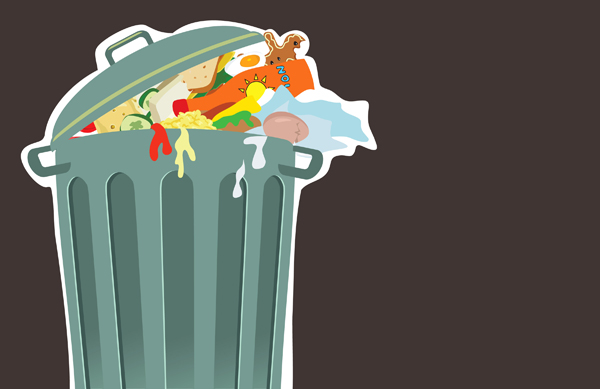Reducing Food Waste: Small Change = Big Impact + Savings
 Like those in many American households, your refrigerator may be stocked with food that is destined to fill your trash bin rather than the bellies of your family members. How often do you find slimy vegetables, expired jars, or containers with moldy left-overs? What about a loaf of stale bread or far too soft fruit on your kitchen countertops? Or that package of chicken that you defrosted but never used because your family convinced you to order take-out instead. Of course, this waste doesn’t even include what your children toss out from their lunch boxes.
Like those in many American households, your refrigerator may be stocked with food that is destined to fill your trash bin rather than the bellies of your family members. How often do you find slimy vegetables, expired jars, or containers with moldy left-overs? What about a loaf of stale bread or far too soft fruit on your kitchen countertops? Or that package of chicken that you defrosted but never used because your family convinced you to order take-out instead. Of course, this waste doesn’t even include what your children toss out from their lunch boxes.
Most parents feel guilty when food goes to waste, but don’t realize that these small lapses link to a much bigger problem. In his recent book titled American Wasteland: How America Throws Away Nearly Half of Its Food, author Jonathan Bloom writes: “Every day, America wastes enough food to fill the Rose Bowl,” adding that our “per capita food waste has doubled since 1974.” In fact, food is discarded in every step of the way from farm to fork, but Bloom says households play a main role in unnecessary waste.
“A couple of years ago, my husband and I made a New Year’s resolution to waste less food because we recognized that we were throwing away so much of it,” says Katie Farmand, an Orlando mom and cookbook author. Why are we so wasteful? “People don’t really think about where their food comes from, other than the grocery store. They don’t consider the farmer’s work and resources invested in growing and preparing the food,” says Farmand. “For the most part, food is so available to us in North America that even if we don’t eat half the strawberries, we’ll just buy another fresh pack next week.”
Jennie Lyon, a Florida-based green lifestyle blogger, blames food waste on the hectic lifestyles of families. “You get to the store and ask yourself, ‘Am I out of that food item? I don’t know.’ Then, though uncertain, you simply toss the product into your grocery cart and later discover that you did already have it; thus, overbuying leads to waste.”
The bad news? Food waste has dire environmental consequences. Take that package of chicken on the counter. If uneaten, not only is the chicken wasted, but also the animal feed, water, and fossil fuels that went into processing, packaging, transport, and refrigeration. More fuel is needed to move the discarded food to a landfill where the unused chicken eventually rots producing greenhouse gas. Or as Bloom writes, “climate change coming directly from your kitchen.”
Overwhelmed by how to combat the issue? Don’t be. Tackling food waste is doable and a powerful way for individuals to affect change. “It actually can save you a ton of money,” explains Lyon. How much money? A recent report published by the National Resource Defense Council states that the average American family spends $2,275 annually on food they never eat! Go green to save green with these tips:
Shop Smart:
- Do inventory. Take a look at your pantry, fridge and freezer to determine what you have and need.
- Create a list. Keep a magnetic pre-formatted grocery list on your refrigerator to easily check off depleted items as you run out.
- Menu plan. Choose recipes for the week and plan your shopping list accordingly, including intentions for partially used packages. For example, if you only need a handful of carrots for one recipe, consider a secondary use for the remainder of the bag.
Meal Management:
- Freeze for ease! Lyon advises “cook meals ahead (on the weekends) and freeze them” to save time on busy weeknights. And on the flip side ─ freeze leftovers or food that you won’t have time to eat before it goes bad.
- Use leftovers creatively. For example, Lyon says, “If I have strawberries starting to turn, I’ll make a smoothie for breakfast. Or if I have a lot of vegetables, like carrots or potatoes, I’ll prepare soups.”
- Understand expirations. “Best before” dates are only a guide and sometimes good food doesn’t have to look perfect. Stale (but not mouldy) bread works great for croutons, French toast, or strata; as do brown bananas for banana bread. Remove brownish leaves from lettuce, cut bruises from apples, and enjoy the rest!
Scrap Your Scraps:
- Start composting. Create a mixture of biodegraded organic matter from yard waste or kitchen leftovers. Farmand says she uses food scraps to fertilize flowers and vegetable gardens. Consult a local ‘green’ expert or consider investing in a small electronic composter.
Household Helpers:
- Team green! The whole family can take part in waste-reducing behaviors. Lyon says she’s passed her green values onto her 11-year-old son. “If he has any lunch leftovers, such as fruit, he’ll use it as an afternoon snack.”
Local Resources:
- Homegrown Local Food Cooperative (HomeGrownCoop.org)
- Orlando’s Green Works (CityOfOrlando.net/GreenWorks)
- Orange County Extension Education Center (Orange.ifas.ufl.edu)
- Florida Department of Environmental Protection (dep.state.fl.us)







